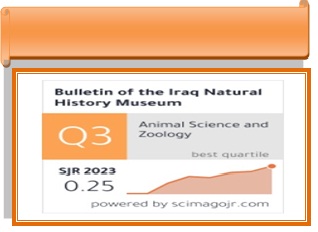ESTIMATION OF GENETIC VARIATIONS IN DIFFERENT TAXA IN BRASSICACEAE BY RAPD AND ISSR ANALYSIS
DOI:
https://doi.org/10.26842/binhm.7.2018.15.1.0001Keywords:
Brassicaceae, Genetic similarity, ISSR, Polymorphism, RAPDAbstract
Twelve species from Brassicaceae family were studied using two different molecular techniques: RAPD and ISSR; both of these techniques were used to detect some molecular markers associated with the genotype identification. RAPD results, from using five random primers, revealed 241 amplified fragments, 62 of them were polymorphic (26%).
ISSR results showed that out of seven primers, three (ISSR3, UBC807, UBC811) could not amplify the genomic DNA; other primers revealed 183 amplified fragments, 36 of them were polymorphic (20%). The similarity evidence and dendrogram for the genetic distances of the incorporation between the two techniques showed that the highest similarity was 0.897 between the varieties red cabbage and red ornamental cabbage, meanwhile the lowest similarity index was between the varieties red radish and green ornamental cabbage (0.169); thus these RAPD and ISSR markers have the possibility for the identification of species or varieties and the description of genetic variation within the varieties. Furthermore, it could be concluded that the Brassicaceae taxa have a suitable amount of genetic variance and a wide range in the genetic principle of the studied genotypes which can be used for output improvement.
Downloads
References
Al-Shehbaz, I. A. 1984. The tribes of Cruciferae (Brassicaceae) in the Southeastern United States. Journal of the Arnold Arboretum, 65: 343–373.
Al-Shehbaz, I. A. 2012. A generic and tribal synopsis of the Brassicaceae (Cruciferae). Taxon, 61( 5):931-954.
Appel, O. and Al-Shehbaz, I. A. 2003. Cruciferae. In: Kubitzki, K. and Bayer, C. (eds.), families and genera of vascular plants. 5: 75-174. Springer-Verlag, Berlin, Heidelberg.
Cruz, S. M., Nery, M. C., Pinho, É. D. V. D. R. and Laia, M. L. 2014. Molecular characterization of radish cultivars. Revista Ciência Agronômica, 45(4): 815-822.
Edger, P. P., Heidel-Fischer, H. M., Bekaert, M., Rota, J., Glöckner, G., Platts, A. E., Heckel, D. G., Der, J. P., Wafula, E. K. and Tang, M. 2015. The butterfly plant arms-race escalated by gene and genome duplications. Proceeding of the National Academy of Sciences of the United State of America, 112: 8362–8366.
Franzke, A., Lysak, M. A., Al-Shehbaz, I.A, Koch, M. A. and Mummenhoff, K. 2011. Cabbage family affairs: the evolutionary history of Brassicaceae. Trends Plant Sciences, 16: 108–116.
Gray, A. R. 1993. Broccoli: Brassica oleracea (Italica Group). Genetic improvement of vegetable crops. In Kalloo, G. and Bergh, B. O.(eds.), pp 61-86.
Gomez-Campo, C. and Prakash, S. 1999. Origin and domestication. In: Gomez-Campo C. (eds.), Biology of Brassica coenospecies, Elsevier, Amsterdam, pp 33-38.
Grudman, H., Schneider, C., Hartung, D., Daschner, F. and Pith, T. 1995. Discriminatory power of three DNA typing techniques for P. aeruginosa. Clinical Microbiology, 3:528-532.
Hammer, Ø., Harper, D. A. T, and Ryan, P .D. 2001. PAST: a palaeontological statistic software package for education and data analysis. Paleontologia Electronica, 4(1): 1-9.
Harborne, J. B., Boulter, D. and Turner, B. L. 1971. Chemotaxonomy of the Leguminosae. Academic Press, London, New York, 612pp.
Hu, J. and Quiros, C. F. 1991. Identification of broccoli and cauliflower cultivars with RAPD markers. Plant Cell Report, 10: 505-511.
Kurane, J., Shinde, V. and Harsulkar, A. 2009. Application of ISSR marker in pharmacognosy: a current update. Pharmacognosy Reviews, 3(6): 216-228.
Meinke, D. W., Cherry, J. M., Dean, C., Rounsley, S. D. and Koornneef, M. 1998. Arabidopsis thaliana: a model plant for genome analysis. Science, 282: 662–682.
Prasad, M. P. 2014. Determination of molecular characterization of Brassicaceae family using RAPD molecular markers. International Journal Advance Research Biology Sciences, 1(2): 56-61.
Soltis, P. S., Soltis D. E. and Doyle, J. J. 1992. Molecular systematics of plants Chapman and Hall, New York, 11pp.
Vekemans, X., Poux, C., Goubet, P. M. and Castric, V. 2014. The evolution of selfing from outcrossing ancestors in Brassicaceae: what have we learned from variation at the S-locus?. Journal Evolutionary Biology, 27: 1372–1385.
Warwick, S. I., Mummenhoff, K., Sauder, C., Koch, M. A. and Al-Shehbaz, I. A. 2010. Closing the gaps: phylogenetic relationships in the Brassicaceae based on DNA sequence data of nuclear ribosomal ITS region. Plant System Evolutionary, 285: 209–232.
Williams, J. G. K., Kubelik, A. R., Livak, K. J., Rafalski, J. A. and Tingey, S. V. 1990. DNA polymorphisms amplified by arbitrary primers are useful as genetic markers. Nucleic Acids Research, 18: 6231-6235.
Yang, Y. W., Lai, K. N., Tai, P. Y. and Li, W. H. 1999. Rates of nucleotide substitution in angiosperm mitochondrial DNA sequences and dates of diversification between Brassica and other angiosperm lineages. Journal of Molecular Evolution, 48: 597–604.
Zunk, K., Mummenhoff, K. and Hurka, H. 1999. Phylogenetic relationships in tribe Lepidieae (Brassicaceae) based on chloroplast DNA restriction site variation. Canadian Journal of Botany, 77: 1504–1512.























